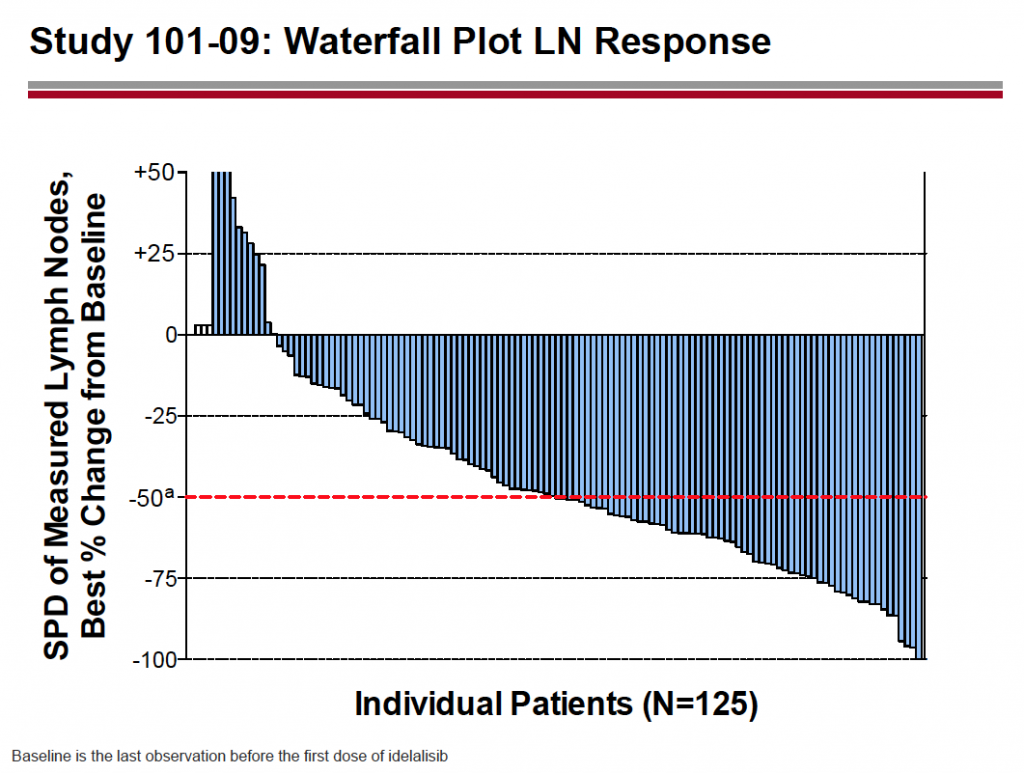Medivation announce interim results of PREVAIL in pre-chemotherapy CRPC
This morning Medivation and Astellas announced the interim results of the PREVAIL trial in the pre-chemotherapy castrate resistant prostate cancer (CRPC) setting.
The independent data monitoring committee (IDMC) recommended stopping the trial early due to significant efficacy and unblinding the data.
Accordingly, the press release headline stated that:
“Study Will Be Stopped Early and Enzalutamide Will Be Offered to All Qualified Study Participants; 30% Reduction in the Risk of Death, Hazard Ratio=0.70 (p < 0.0001); 81% Reduction in the Risk of Radiographic Progression or Death, Hazard Ratio=0.19 (p < 0.0001.”
Now, I don’t know about you, but it’s quite a while since I saw a cancer trial with such an impressive hazard ratio (HR) for overall survival (OS) as well as being highly significant. Essentially, there is a 30% reduction in the risk of death compared with placebo even at this early point.
It was interesting though, that initial sentiments on Twitter suggested that some analysts were bothered by the absolute numbers when comparing the PREVAIL and AA-302 trials in the same setting. Enzalutamide achieved a 2.2 month improvement over placebo whereas abiraterone recorded a 5.2 month advantage, although in their case, the curve was only trending towards survival and did not cross the significance line.
Since the drugs were not compared in a head to head study, you can’t really compare apples with oranges even though the placebo arms were similar, at around 30 months each. The important point here is that one trial achieved statistical significance and the other did not. The clue is in the trial design and relative size of the respective studies.
Curious to see what urologist reactions were to the announcement, I checked out sentiments on Twitter, including Dr Benjamin Davies (Univ. of Pittsburgh) and Prof Bertrand Tombal (Leuven):
@dsobek also easier to use. No steroids. Urologists will love it. It’s like casodex which we use in spades
— daviesbj (@daviesbj) October 22, 2013
PREVAIL (enzalutamide pre-chemo) positive..Great news for doctor and patients. http://t.co/RUirE6Tx0D
— Bertrand TOMBAL (@BertrandTOMBAL) October 22, 2013
The other side of the coin, though, is some scepticism and nihilism from the analyst corner:
Sell-Side: I’m really concerned that 3/4 of Xtandi patients in PREVAIL study are still alive. #DERP $MDVN
— Adam Feuerstein (@adamfeuerstein) October 22, 2013
I’m kind of shocked that anyone would even think that, never mind say it. To be clear, those are not Adam’s words, but rather he’s summarising analyst chatter on the conference call (not verbatims), albeit in his own inimitable fashion. Obviously the point of new therapies is that you want patients to live longer, surely?! Their obvious disappointment, however, can be put into a context of sorts:
my guess is $MDVN sell-side analysts would’ve rather seen better mOS and weaker HR vs zytiga…which is why they’re analysts and not doctors.
— zach (@zbiotech) October 22, 2013
Sometimes I despair of people in the industry’s inability to understand basic statistics. What we have is snapshot, not the full data, that will come at a conference presentation when the full analysis is conducted post unblinding. Personally, I think these interim results, based on the HR and P value are encouraging, but what we really need to see are the survival curves because they tell a much more complete picture.
It should be noted that what many of the Wall Street analysts appear to have missed is that what we have is an early slice of the data – median overall survival (MOS) has obviously not yet been reached!
It is also unfortunate that Medivation only used a small sample of at risk patients (n=59) at 30 months to estimate the survival since the rest were censored or dead as David Miller keenly observed:
@zbiotech Found out: 59 is the total “at risk” at 30 mo. Everyone else in the trial is censored (69%) or dead (31%) on the KM curve.
— David Miller (@AlpineBV_Miller) October 22, 2013
This is a great way to create confusion unless you are expressly clear in the press release.
That said, if the trial is unblinded and placebo patients still alive are allowed to switch over, then we may only see the MOS for the enzalutamide arm in the future and not the comparator since the data will be confounded by switching.
 For a different perspective, I also reached out to Prof Bertrand Tombal (Leuven), one of the lead European investigators in the trial, for his measured and considered thoughts on some of the key issues arising from this news:
For a different perspective, I also reached out to Prof Bertrand Tombal (Leuven), one of the lead European investigators in the trial, for his measured and considered thoughts on some of the key issues arising from this news:
1) What are your top line impressions of the PREVAIL data?
“I am a Urologist and every minutes patients are dying from prostate cancer, despite the last-years logarithmic infatuation in drugs. On top of that, recent data from Sweden that the proportion of patients dying from PCa without having received docetaxel is much larger than anticipated. So having more drug in the pre-docetaxel setting is critical, either to delay its use or treat patients that are and will remain unfit for it.”
“As a urologist, I am absolutely impressed by the delay in PFS and the unprecedented HR of 0.19 in radiographic progression-free survival. That speak to me….In addition, it does it without compromise and discussion on the impact on survival 0,70 and a 30% reduction in the risk of death..What more toxicity, especially when you know the limited toxicity of the drug.”
“It is funny to see how people have a different look of the 2 face of the co-primary endpoint coin…I look at PFS because it speaks to my patients.”
2) Many people in the US appear to be concerned that the absolute magnitude of the enzalutamide benefit is lower than that for abiraterone in the pre-chemotherapy setting (2.2 vs 5.2 months), what are your thoughts on this?
“I still have trouble understanding the meaning of a difference in median survival when the median are not reached ??? That’s computed median, arithmetic medicine if you wish. I want to see the curve…There is not mystery that regulators approve drugs based upon hazard ratios and not medians. They are much better representation of the benefit. In addition, due to the availability during the trial of approved drugs known to improve overall survival, placebo patients would be expected to have taken other drugs to increase survival.”
3) Not many countries in Europe have reimbursed abiraterone in the pre-chemo setting, is it likely that enzalutamide will be treated differently based on the fact it shows a significant OS?
“I don’t know, but in Europe most countries values Qualys and ICER, and for qualys you need to extent survival…It is more complex that a simple HR and we will need more results.”
4) Presuming enzalutamide is approved pre-chemo, which drug should urologists give first: abiraterone or enzalutamide?
“That a tricky one…Let’s say that the most popular drug so far is still bicalutamide 50 mg, and in absence of direct comparison between drug, convenience for the patient and the urologist is very often a very discriminating choice…”
5) The cumulative cost of prostate cancer care is increasing as new drugs are approved, is it going to be cost effective to treat for 32 months with an expensive new drug for only a 2 month survival benefit or do we need more effective treatment options?
“That is the real challenge, especially with the European Perspective. In Europe, where the access to treatment is mostly based on solidarity rather than private insurance, it means political choices, ethical choices and a lot of thinking on new model…based on performance, sure.”
Well said, sir!
Ultimately, we need to wait to see the full presentation and look at the survival curves before making a more informed decision. Hopefully, this data will be presented at the ASCO GU meeting in January, making a very interesting start to the 2014 cancer conference calendar.

 With around 6,000 posters and many oral presentations from leading researchers, there is usually some interesting early data coming out from AACR. This year was no exception. My pile of poster handouts is over 6” thick with more already coming in my email! My fervent wish for next year is that more scientists take to the QR code method of sharing their posters – aside from being green and saving trees, it’s also considerably easier on the back! Another welcome development would be putting the posters online for later download as many of the European meetings already do.
With around 6,000 posters and many oral presentations from leading researchers, there is usually some interesting early data coming out from AACR. This year was no exception. My pile of poster handouts is over 6” thick with more already coming in my email! My fervent wish for next year is that more scientists take to the QR code method of sharing their posters – aside from being green and saving trees, it’s also considerably easier on the back! Another welcome development would be putting the posters online for later download as many of the European meetings already do. Zytiga already has Compendia listing through mention in the NCCN Guidelines with level 2a evidence in the pre-chemotherapy setting, essentially listed with ketoconazole. Several industry friends with access to market data have mentioned that the pre-chemotherapy share for abiraterone is already around 20-25%, not bad at all given it doesn’t have full approval prior to docetaxel use and has been on the US market less than a year.
Zytiga already has Compendia listing through mention in the NCCN Guidelines with level 2a evidence in the pre-chemotherapy setting, essentially listed with ketoconazole. Several industry friends with access to market data have mentioned that the pre-chemotherapy share for abiraterone is already around 20-25%, not bad at all given it doesn’t have full approval prior to docetaxel use and has been on the US market less than a year. Last week, brought negative data as
Last week, brought negative data as 